May 20, 2025 | 06:05 GMT +7
May 20, 2025 | 06:05 GMT +7
Hotline: 0913.378.918
May 20, 2025 | 06:05 GMT +7
Hotline: 0913.378.918
On May 19, the Ministry of Agriculture and Environment, in collaboration with the Food and Agriculture Organization of the United Nations (FAO), organized a Consultation Workshop on the Draft Soil Health Strategy and Action Plan. This event is part of the project "Support for Developing the National Soil Health Strategy and Action Plan," funded by FAO and implemented by the Soil and Fertilizer Institute. The project contributes to the implementation of several key tasks under the "Sectoral Duty on Enhancing Soil Health and Crop Nutrition Management until 2030, with a vision to 2050."
The soil health strategy and action plan integrate risk management related to food security, food safety, and the misuse of agricultural inputs such as fertilizers and pesticides.
Vietnam currently has 11.6 million hectares of agricultural land, including 6.7 million hectares for annual crops (3.9 million hectares for rice and 2.8 million hectares for other annual crops) and 4.9 million hectares for perennial crops. However, soil quality is facing serious challenges. Up to 75% of the land area consists of sloping terrain, with 50% having a gradient of over 20 degrees, significantly increasing the risk of erosion. In reality, 60% of the land area suffers from erosion, with soil loss exceeding 11 tons per hectare per year, and 30% of the area experiences severe erosion (more than 20 tons per hectare per year). Soil acidity is also an alarming issue, with 70% of the land having a pH below 6.0.
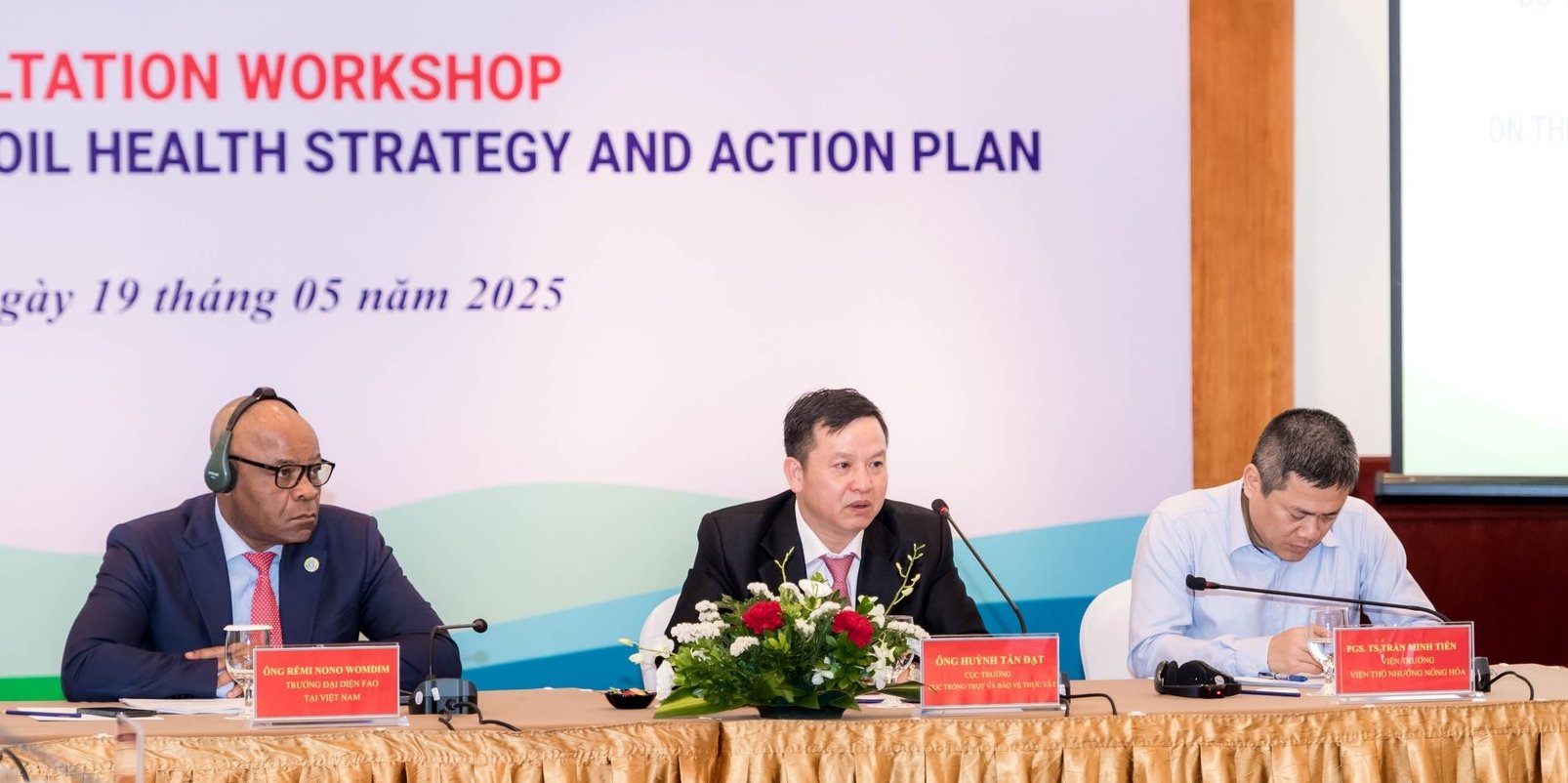
Mr. Huynh Tan Dat, Director General of the Crop Production and Plant Protection Department, spoke at the consultation workshop on Draft Soil Health Strategy and Action Plan. Photo: Linh Linh.
Currently, 50% of Vietnam’s agricultural land is deficient in nitrogen, 70% in phosphorus, 60% in potassium, 72% in calcium, and 48% in magnesium. Salinity intrusion is also increasing significantly in the Mekong Delta region, while soil pollution caused by the accumulation of heavy metals such as arsenic and copper is becoming more common in rice-growing areas and locations near household and industrial waste sites.
According to a report by the Ministry of Natural Resources and Environment (2020), about 44% of agricultural land in Vietnam has undergone degradation. Of this, 1% is classified as severely degraded, 14% moderately degraded, and 29% lightly degraded. Common forms of degradation include erosion, drought, laterite formation, fertility decline, salinization, and acid sulfate contamination.
The Draft Soil Health Strategy and Action Plan integrates issues related to food security, food safety, and the rational use of agricultural inputs and lays the foundation for transitioning to a low-carbon, sustainable, and climate-resilient agricultural production model.
Moreover, the Strategy incorporates the “One Health” approach, emphasizing the interconnectedness of “healthy soil – healthy plants – healthy people and animals – healthy environment.” This holistic view aims to enhance the mobilization of scientific, financial, and technological resources for more effective implementation.

Mr. Rémi Nono Womdim, FAO Representative in Vietnam. Photo: Linh Linh.
Mr. Rémi Nono Womdim, FAO Representative in Vietnam, emphasized that healthy soil is an indispensable foundation for sustainable agriculture. With only about 11.5 million hectares of agricultural land – equivalent to 0.11 hectares per person – Vietnam's farmland is not only limited in size but also highly vulnerable. Soil erosion, acidity, excessive use of chemical fertilizers, urbanization, and climate change are the main causes of soil degradation, reducing productivity, and diminishing the quality of agricultural products.
According to Mr. Rémi, the National Soil Health Strategy to 2030 with a vision toward 2050, along with the accompanying Action Plan, is designed to suit Vietnam’s current development context and institutional framework. This strategy also aims to align with international standards and enhance the competitiveness of Vietnamese agricultural products in the global market.
Mr. Huynh Tan Dat, Director General of the Crop Production and Plant Protection Department, highlighted specific targets Vietnam aims to achieve by 2030. These include completing a comprehensive database on the quality of major soil types based on physical, chemical, and biological indicators, coupled with data on fertilizer usage for key crops. Additionally, Vietnam plans to develop a set of criteria and a classification scale to assess soil health for crop production that is suitable for the country’s ecosystems while aligning closely with regional and international standards.
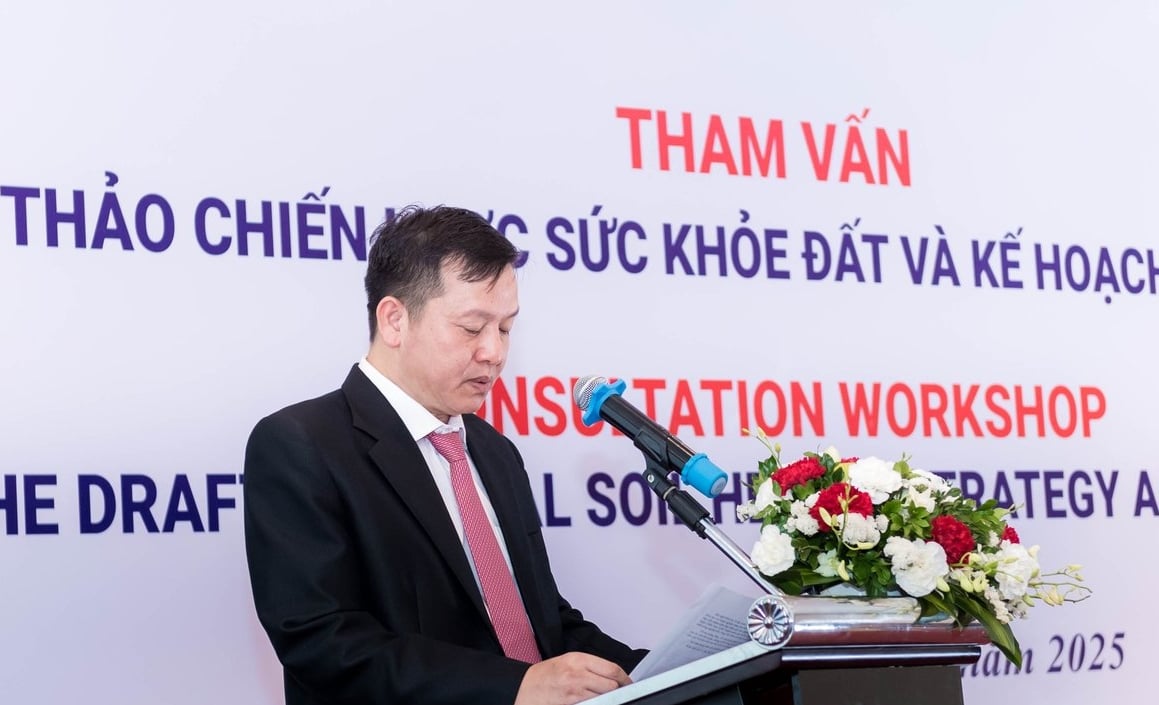
Mr. Huynh Tan Dat, Director General of the Crop Production and Plant Protection Department, spoke at the consultation workshop. Photo: Linh Linh.
Completing sustainable farming practices that promote the efficient use of fertilizers, reduce nutrient loss, improve soil quality, and protect soil biodiversity is essential. These efforts also contribute to reducing greenhouse gas emissions in agriculture and strengthening the capacity of technical staff, managers, and local communities.
Looking ahead to 2050, Vietnam aims to become a regional leader in the capacity and effectiveness of managing soil health and crop nutrition. According to Mr. Dat, achieving this goal will require strong support from the international community, the private sector, scientists, and development organizations, particularly in terms of resources, knowledge, and technology.
From a public health perspective, Dr. Pham Duc Phuc, an expert in the One Health approach, emphasized that the soil health management strategy should focus on early identification of high-risk factors in soil that may affect human and animal health, including both livestock and wildlife.
He specifically highlighted concerns over antibiotic residues and the presence of antibiotic-resistant bacteria in soil, which can pose exposure risks to agricultural workers and increase the threat of antimicrobial resistance in humans. Dr. Phuc also stressed the urgent need to develop an integrated database system that links related health components, including soil microbiomes, to support analysis, early warning, and effective risk management.
Translated by Kieu Chi
![Reducing emissions from rice fields: [Part 1] Farming clean rice together](https://t.ex-cdn.com/nongnghiepmoitruong.vn/608w/files/news/2025/05/05/z6509661417740_a647202949c539012a959e841c03e1d3-nongnghiep-143611.jpg)
(VAN) Growing clean rice helps reduce environmental pollution while increasing income, allowing farmers to feel secure in production and remain committed to their fields for the long term.
/2025/05/19/5136-1-144800_230.jpg)
(VAN) The Nghe An Provincial People's Committee has just approved the list of beneficiaries eligible for revenue from the Emission Reductions Payment Agreement (ERPA) in the North Central region for the year 2025.
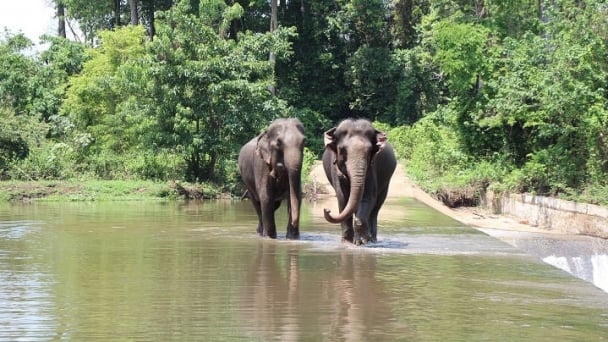
(VAN) 14 out of 35 domesticated elephants in Dak Lak province have had their living conditions improved, with 11 of them currently participating in the non-riding elephant tourism model.
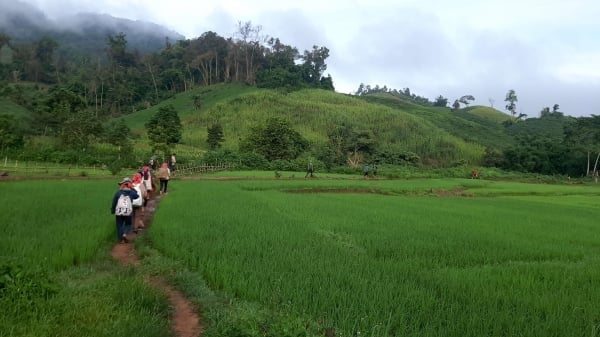
(VAN) Muong Nhe Nature Reserve hopes that being upgraded to a national park will lay the foundation for forest protection efforts to be carried out in a systematic, modern, and sustainable manner.
/2025/05/16/3923-2-171845_52.jpg)
(VAN) Lower costs, higher yields, and improved soil quality are outstanding benefits that soybeans bring when integrated into the crop rotation system.
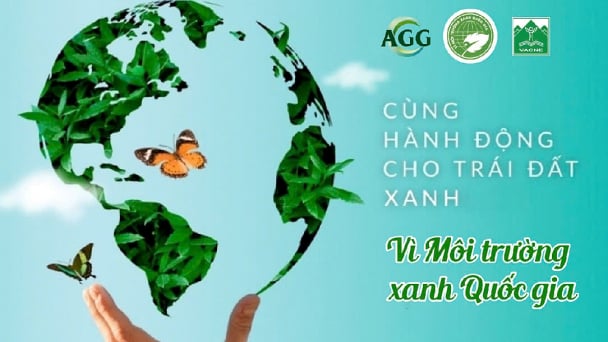
(VAN) The 'For a Green National Environment' programme aims to promote a green lifestyle, support businesses in implementing ESG practices, and turn Net Zero commitments into concrete actions.